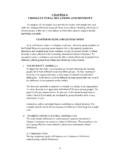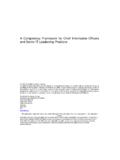Transcription of WHO GLOBAL COMPETENCY MODEL
1 1 WHO GLOBAL COMPETENCY MODEL 1. Core Competencies 1) COMMUNICATING IN A CREDIBLE AND EFFECTIVE WAY Definition: Expresses oneself clearly in conversations and interactions with others; listens actively. Produces effective written communications. Ensures that information is shared. EFFECTIVE BEHAVIOURS INEFFECTIVE BEHAVIOURS 1. Speaks and writes clearly, adapting communication style and content so they are appropriate to the needs of the intended audience 2. Conveys information and opinions in a structured and credible way 3. Encourages others to share their views; takes time to understand and consider these views 4.
2 Ensures that messages have been heard and understood 5. Keeps others informed of key and relevant issues 1. Does not share useful information with others 2. Does little to facilitate open communication 3. Interrupts or argues with others rather than listening 4. Uses jargon inappropriately in interaction with others 5. Lacks coherence in structure of oral and written communications; overlooks key points 2) KNOWING AND MANAGING YOURSELF Definition: Manages ambiguity and pressure in a self-reflective way. Uses criticism as a development opportunity.
3 Seeks opportunities for continuous learning and professional growth. EFFECTIVE BEHAVIOURS INEFFECTIVE BEHAVIOURS 1. Works productively in an environment where clear information or direction is not always available 2. Remains productive when under pressure 3. Stays positive in the face of challenges and recovers quickly from setbacks 4. Uses constructive criticism to improve performance 5. Shows willingness to learn from previous experience and mistakes, and applies lessons to improve performance 6. Seeks feedback to improve skills, knowledge and performance 1.
4 Demonstrates helplessness when confronted with ambiguous situations 2. Demonstrates a lack of emotional control during difficult situations 3. Reacts in a hostile and overly defensive way to constructive criticism 4. Fails to make use of opportunities to fill knowledge and skills gaps 5. Consistently demonstrates the same behaviour despite being given feedback to change 6. Transfers own stress or pressure to others 2 3) PRODUCING RESULTS Definition: Produces and delivers quality results. Is action oriented and committed to achieving outcomes.
5 EFFECTIVE BEHAVIOURS INEFFECTIVE BEHAVIOURS 1. Demonstrates a systematic and efficient approach to work 2. Produces high-quality results and workable solutions that meet client needs 3. Monitors own progress against objectives and takes any corrective actions necessary 4. Acts without being prompted and makes things happen; handles problems effectively 5. Takes responsibility for own work 6. Sees tasks through to completion 1. Focuses on the trivial at the expense of more important issues 2. Provides solutions that are inappropriate or conflict with other needs.
6 3. Focuses on process rather than on outcomes 4. Delivers incomplete, incorrect or inaccurate work 5. Fails to monitor progress towards goals; fails to respect deadlines 6. Delays decisions and actions 4) MOVING FORWARD IN A CHANGING ENVIRONMENT Definition: Is open to and proposes new approaches and ideas. Adapts and responds positively to change. EFFECTIVE BEHAVIOURS INEFFECTIVE BEHAVIOURS 1. Is receptive to new ideas and working methods. 2. Actively supports change initiatives 3. Recognises opportunities for improvement and proposes workable solutions 4.
7 Actively seeks to apply new methods and technologies to improve work processes 5. Adapts readily and efficiently to changing priorities and demands 1. Is reluctant to change when faced with new demands or challenges 2. Shows little flexibility in attitude when faced with new ideas 3. Holds outdated views despite changes in the work environment 4. Becomes negative in outlook when faced with change 3 5) FOSTERING INTEGRATION AND TEAMWORK Definition: Develops and promotes effective relationships with colleagues and team members. Deals constructively with conflicts.
8 EFFECTIVE BEHAVIOURS INEFFECTIVE BEHAVIOURS 1. Works collaboratively with team members to achieve results 2. Encourages co-operation and builds rapport among fellow team members 3. Supports and acts in accordance with team decisions 4. Accepts joint responsibility for team s successes and shortcomings 5. Identifies conflict early and supports actions to facilitate its resolution 1. Focuses only on achieving personal goals at the expense of team objectives 2. Works independently in settings which require group work 3. Avoids sharing knowledge, information and expertise with team members 4.
9 Exploits divisions in the team 5. Avoids dealing with conflict 6. Shows little support for, or undermines fellow team members 6) RESPECTING AND PROMOTING INDIVIDUAL AND CULTURAL DIFFERENCES Definition: Demonstrates the ability to work constructively with people of all backgrounds and orientations. Respects differences and ensures that all can contribute. EFFECTIVE BEHAVIOURS INEFFECTIVE BEHAVIOURS 1. Understands and respects cultural and gender issues and applies this to daily work and decision making 2. Relates and works well with people of different cultures, gender and backgrounds 3.
10 Examines own behaviour and attitudes to avoid stereotypical responses 4. Considers issues from the perspective of others 5. Draws on diversity of skills, backgrounds and knowledge of people to achieve more effective results 1. Is unwilling to view issues from the perspective of others 2. Discriminates against individuals or groups 3. Makes judgements based on perceived cultural stereotypes 4. Seeks to relate only to persons of similar culture, religion, gender or level 5. Rationalises all potential conflict by attributing the cause to differences in culture 4 7) SETTING AN EXAMPLE Definition: Acts within WHO s professional, ethical and legal boundaries and encourages others to adhere to these.


















